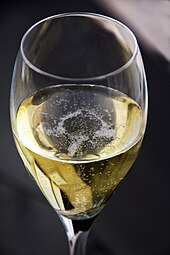
Light-bodied rose-style wines can range in colour, from pale pink to orange rose or even brown red. Typically rose wines have a crisp acid finish and cherry raspberry fruit characters. Although some will exhibit citrus, tropical, confectionery, or even developed characters, depending on grape variety, methods of production,and the age of the wine.
Like white wines, rose wines are ideally served chilled. In the case of full-bodied red wines, colour can range from a vibrant crimson red,or purple red for younger wines, through to brick red or brown red for older wines. My wine has a crimson red with just a hint of a brown hue on the edge.The aroma, flavour, taste, and mouthfeel attributes of red wine again depend on grape variety, wine style,the climate of the wine region, and the duration of any maturation. Full-bodied red wines lend themselves to oak maturation and malolactic fermentation.So they'll likely exhibit a combination of fruit and oak-related aromas and flavours. In the case of aged red wines, the fruit attributes may no longer be as prominent, instead developed characters such as leather, tobacco, meaty, savoury, nutty, or earthy notes may evolve.Young red wines can be quite tannic, but with ageing, tannins will soften. Again, mouthfeel is very much dependent on grape variety, wine style, climate and ageing. My wine's exhibiting really intense ripe berry fruit characters.There's lots of blackcurrant, plum and cherry with a hint of herbaceousness and some spicy oak as well. On the palate, lots of dark fruit. Really juicy forest fruits, plum, and black cherries. It's really rich and full on the palate,and it's got a bit of a warming finish, so that's probably due to just a little bit of a higher alcohol.The sensory attributes of red wine are highly dependent on grape variety, wine style, the climate of the region and the duration of any maturation. Lighter-bodied styles, including rosé wines, will tend to exhibit red berry, floral and confectionary notes, but they may also exhibit some developed notes. Fuller-bodied red wine styles are more likely to exhibit a combination of both varietal expression and oak influence. As red wines age, the intensity of fruit characters will diminish and developed characters become more prominent; tannins will also soften.
Appearance:
from pale pink to orange rose to brown red (for rosé wines); then from crimson red to purple red (for younger red wines) to brick red or brown red (for older red wines).
Aroma and flavour:
fruit characters (dependent on grape variety):
berry fruit (blackberry, blackcurrant, blueberry, cranberry, mulberry, raspberry, strawberry); tree fruit (cherry, plum); floral (blossom, honeysuckle, jasmine, rose, violet); spice (black pepper, licorice); vegetal (asparagus, capsicum, cucumber, cut grass, grassy, herbal, mint, tobacco, tomato leaf); other (barnyard, confectionary cola, dusty, earthy, fruitcake, forest floor, jammy, musk, perfumed, raisin, tar, truffle).
developed characters:
allspice, bacon, caramel, cedar, charry, chocolate, cigar box ,cinnamon, clove, coconut, coffee, dusty, mocha, nutty, pencil shavings, resinous, roasted, spicy, sandalwood, sawdust, smoky, toasty, vanilla (oaked red wine); barnyard, chocolate, coffee, earthy, fig, leather, meaty, mossy, mushroom, prune, savoury, soy, tar, tea leaf, tobacco, truffle, walnut (aged red wine).
Taste and mouthfeel:
The taste and texture of red wines very much depends on grape variety and climate, wine style, and the use of any oak or bottle maturation. Rosé wines should exhibit crispy acidity, but fuller-bodied styles tend to have softer acidity. Young red wines can be tannic, even astringent, but with maturation, tannins will soften. Mouthfeel descriptors for red wines can range from aggressive, drying or puckering to fine, silky, supple and velvety.
Sweet wine evaluation
Sweet white wines are made in various styles, from semi-sweet late harvest wines, to rich, Botrytis-style wines. Semi-sweet styles typically contain up to 30 g/L of residual sugar, whereas sweeter styles might contain as much as 200 g/L. The sensory properties of different styles of sweet wine depend on grape variety and the method by which the higher sugar concentrations of grapes are achieved. Semi-sweet and non-Botrytis style sweet wines tend to exhibit fruity, floral and confectionary notes, whereas Botrytis-style wines are more complex, with honey, marmalade and in some cases, spicy oak notes.
Appearance:
from pale yellow to golden
Aroma and flavour:
fruit characters:
citrus (grapefruit, lemon, lime); tree fruit (apple, apricot, peach, pear); floral (blossom, honeysuckle, rose, violet); tree fruit (apple, pear); tropical fruit (guava, lychee, melon, passionfruit, pineapple); other (confectionary, honey, musk, rosewater, perfumed).
developed characters:
butterscotch, caramel, clove, dried fruit, fig, nutty, nougat, prune, raisin, spice, toffee
Botrytis characters:
cumquat, dried apricot, candied orange, marmalade, orange peel
Taste and mouthfeel:
Semi-sweet styles tend to be lighter-bodied, whereas the higher sugar content of sweeter styles increases the viscosity, making them more syrupy and luscious. Irrespective of the level of sweetness, there should be sufficient underlying acidity to balance the sugar, ensuring a clean, crisp finish.



No comments:
Post a Comment